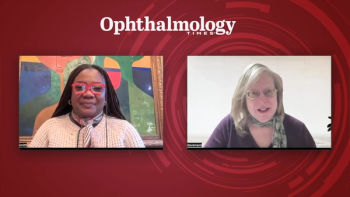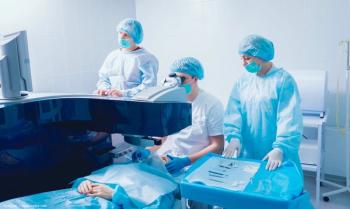
- Ophthalmology Times: July/August 2025
- Volume 50
- Issue 4
Surgical innovation in dry eye disease: Salivary gland transplant
Key Takeaways
- Dry eye disease involves tear film instability, inflammation, and neurosensory abnormalities, with severe cases posing treatment challenges.
- Minor salivary gland transplantation (MSGT) offers a less-invasive surgical option for severe DED, providing sustained lubrication and improved ocular health.
A novel use of minor salivary glands offers lasting relief and visual improvement.
Dry eye disease (DED), as defined by the Tear Film and Ocular Surface Society Dry Eye Workshop II (TFOS DEWS II), is a multifactorial disease of the ocular surface. It is characterized by a loss of homeostasis of the tear film and is accompanied by ocular symptoms.
The etiological roles of DED are tear film instability and hyperosmolarity, ocular surface inflammation and damage, and neurosensory abnormalities.1 The burden of DED in ophthalmology is highlighted by community-based estimates indicating epidemic proportions in countries with large aging populations.2
Although a wide array of therapeutic options exists for managing DED, the most severe forms—particularly those arising from conjunctival cicatricial disorders such as Stevens-Johnson syndrome (SJS) and ocular cicatricial mucous membrane pemphigoid—often pose a challenge because of the near-total or total loss of tear production.3 Noninvasive treatments are often insufficient in these cases, leaving patients vulnerable to severe complications that can result in blindness.3 This unmet need has driven the exploration of alternative interventions.
Surgical approaches to restoring tear production
Autologous salivary gland transplantation has been explored as a surgical option to provide an alternative source of tear production. Initial attempts focused on major salivary glands, but complications such as duct blockage and excessive tearing limited their use. Minor salivary gland transplantation (MSGT) has emerged as a potentially more favorable approach due to its relative simplicity and fewer complications (Figure).4
The rationale for using minor salivary glands lies in the similarity between saliva and natural tears, both of which contain essential components for ocular surface health.5,6 Minor salivary glands, especially from the labial mucosa, are readily accessible with minimal donor site impact.2,7 For patients with cases of severe DED, MSGT offers an autologous source of lubrication, with no risk of immune rejection.5
Clinical study data suggest that transplanted minor salivary glands can provide sustained lubrication, improving dry eye symptoms and quality of life.5,6,8 In complex ocular surface disease, such as cases of SJS with severe scarring, MSGT can be combined with mucous membrane grafting for a comprehensive ocular surface rehabilitation.9,10
Vazirani et al reported long-term outcomes of a modified MSGT.10 This technique involved transplanting a 20 mm × 15 mm tissue complex from the labial mucosa of the lower lip to the superior bulbar conjunctiva, anchored to the superior rectus muscle. This modification aimed to enhance graft survival and integration. The study data demonstrated a significant and sustained improvement in best-corrected visual acuity over a 3-year follow-up. Additionally, improvements were noted in Schirmer test scores and reductions in ocular surface staining, corneal neovascularization, and opacification, with no serious complications.
MSGT has also shown effectiveness in severe dry eye caused by SJS. Arboleda et al detailed the successful visual rehabilitation of a 67-year-old man with end-stage SJS and severe ocular surface compromise. Following systemic treatment for inflammation, the patient underwent MSGT combined with an eyelid margin mucous membrane graft (MMG) to improve ocular lubrication and reduce keratinization. This resulted in an improvement in the Schirmer test score from
0 mm to 3 mm and reduced keratinization, which then allowed for a successful implantation of a Boston type 1 keratoprosthesis in his right eye, restoring his vision to 20/60 for more than 2 years of follow-up.8
Sharma et al reported significant improvements in clinical parameters in patients with severe dry eye secondary to chronic SJS 1 year after MSGT.11 Nibandhe and Bagga also reported that MSGT has shown promise in treating pediatric congenital alacrimia, with long-term improvement in a child with absent lacrimal glands.12 Su et al emphasized the importance of preoperative assessment of minor salivary gland flow rate (MSGFR), finding a positive correlation between higher MSGFR and better postoperative outcomes in MSGT for severe DED.6
MSGT vs SMGT: Comparing surgical approaches
Submandibular gland transplantation (SMGT) is another surgical option for severe DED, often resulting in a greater increase in tear production than MSGT. However, SMGT carries a higher risk of postoperative reflex epiphora and hyperosmolar tears, potentially leading to corneal edema. MSGT is generally considered less invasive and technically simpler than SMGT. Su et al suggested that SMGT might be more suitable for end-stage refractory DED, whereas MSGT could be effective for less-severe cases.13
MSGT offers several advantages, including being less invasive than SMGT, having a lower risk of epiphora and hyperosmolar tears, and demonstrating long-term improvements in visual acuity and ocular surface health in various severe DED conditions. However, the improvement in tear production might be less than with SMGT, and outcomes can vary. Potential complications include graft failure and temporary sensory disturbances at the donor site.7
Future research should focus on refining surgical techniques to improve graft survival and function, conducting large-scale clinical trials, and gaining a better understanding of the salivary tear film. Combining MSGT with other therapies and assessing long-term patient-reported outcomes are also important areas for future investigation.
In conclusion, MSGT is a promising surgical option for severe DED, particularly for cicatricial conditions such as SJS. The modified technique by Vazirani et al shows significant long-term benefits. Although SMGT may offer greater tear production, the advantages of MSGT in terms of safety and tolerability make it a valuable approach in the surgical management of severe DED.
Juan Carlos Navia, MD
Navia is an assistant scientist with the Ophthalmic Biophysics Center at Bascom Palmer Eye Institute, University of Miami Miller School of Medicine in Florida.
Guillermo Amescua, MD
Amescua is a professor of clinical ophthalmology, medical director of the Ocular Microbiology Laboratory, and director of the Ocular Surface Program at Bascom Palmer Eye Institute. Neither author indicated any financial interests relevant to the subject matter.
References
Craig JP, Nichols KK, Akpek EK, et al. TFOS DEWS II definition and classification report. Ocul Surf. 2017;15(3):276-283. doi:10.1016/j.jtos.2017.05.008
Donthineni PR, Kammari P, Shanbhag SS, Singh V, Das AV, Basu S. Incidence, demographics, types and risk factors of dry eye disease in India: electronic medical records driven big data analytics report I. Ocul Surf. 2019;17(2):250-256. doi:10.1016/j.jtos.2019.02.007
Wakamatsu TH, SantʼAnna AEBPP, Cristovam PC, Alves VAF, Wakamatsu A, Gomes JAP. Minor salivary gland transplantation for severe dry eyes. Cornea. 2017;36(suppl 1):S26-S33. doi:10.1097/ICO.0000000000001358
Singh S, Basu S, Geerling G. Salivary gland transplantation for dry eye disease: indications, techniques, and outcomes. Ocul Surf. 2022;26:53-62. doi:10.1016/j.jtos.2022.07.013
Doctor MB, Basu S. Lacrimal gland insufficiency in aqueous deficiency dry eye disease: recent advances in pathogenesis, diagnosis, and treatment. Semin Ophthalmol. 2022;37(7-8):801-812. doi:10.1080/08820538.2022.2075706
Su JZ, Wang Z, Liu XJ, Lv L, Yu GY. Use of saliva flow rate measurement in minor salivary glands autotransplantation for treatment of severe dry eye disease. Br J Ophthalmol. 2022;106(7):902-907. doi:10.1136/bjophthalmol-2020-317552
Geerling G, Raus P, Murube J. Minor salivary gland transplantation. Dev Ophthalmol. 2008;41:243-254. doi:10.1159/000131093
Arboleda A, Phansalkar R, Amescua G, et al. Preparing the ocular surface for a Boston keratoprosthesis type 1 through en bloc minor salivary gland transplantation and mucous membrane grafting in end-stage Stevens-Johnson syndrome. Cornea. 2023;42(7):912-916. doi:10.1097/ICO.0000000000003262
Sant’ Anna AE, Hazarbassanov RM, de Freitas D, Gomes JÁ. Minor salivary glands and labial mucous membrane graft in the treatment of severe symblepharon and dry eye in patients with Stevens-Johnson syndrome. Br J Ophthalmol. 2012;96(2):234-239. doi:10.1136/bjo.2010.199901
Vazirani J, Bhalekar S, Amescua G, Singh S, Basu S. Minor salivary gland transplantation for severe dry eye disease due to cicatrising conjunctivitis: multicentre long-term outcomes of a modified technique. Br J Ophthalmol. 2021;105(11):1485-1490. doi:10.1136/bjophthalmol-2020-316611
Sharma N, Kumar V, Bari A, et al. The clinical outcomes of minor salivary gland transplantation for severe dry eye disease secondary to chronic Stevens-Johnson syndrome. Ocul Surf. 2024;34:277-282. doi:10.1016/j.jtos.2024.08.010
Nibandhe AS, Bagga B. Long-term outcome of minor salivary gland transplantation for pediatric congenital alacrimia. J AAPOS. 2024;28(3):103903. doi:10.1016/j.jaapos.2024.103903
Su JZ, Zheng B, Wang Z, et al. Submandibular gland transplantation vs minor salivary glands transplantation for treatment of dry eye: a retrospective cohort study. Am J Ophthalmol. 2022;241:238-247. doi:10.1016/j.ajo.2022.05.019
Articles in this issue
4 months ago
The future of imaging is out of this worldNewsletter
Don’t miss out—get Ophthalmology Times updates on the latest clinical advancements and expert interviews, straight to your inbox.













































